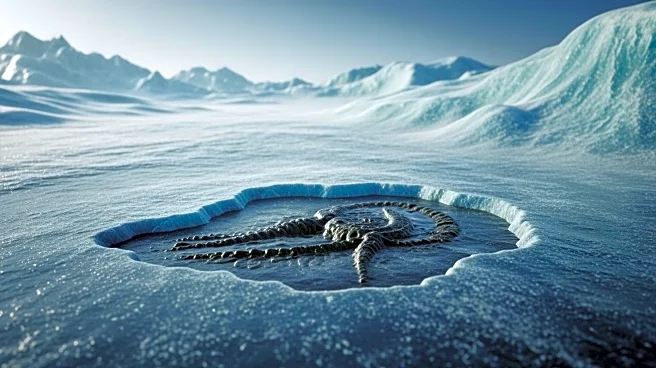What's Happening?
A massive fossilized egg discovered on Seymour Island in Antarctica is prompting scientists to reconsider established theories about ancient marine reptile reproduction. The egg, which is soft-shelled
and leathery, was unearthed from sediment dating back approximately 66 million years. Nicknamed 'The Thing' by the Chilean team who found it, the egg measures about 29 centimeters long and 20 centimeters wide, making it the largest soft-shelled egg ever found. This discovery suggests that some marine reptiles may have laid eggs rather than giving live birth, challenging previous assumptions. The egg's proximity to fossils of Kaikaifilu hervei, a giant mosasaur, has led researchers to speculate that it may have belonged to a large marine reptile.
Why It's Important?
The discovery of the soft-shelled egg in Antarctica is significant as it challenges long-held beliefs about dinosaur reproduction. Traditionally, it was thought that early dinosaurs laid hard-shelled eggs, but this finding suggests that soft-shelled eggs may have been more common. This has implications for understanding the evolution of reproductive strategies among ancient reptiles. Additionally, the preservation of such delicate fossils in Antarctica highlights the region's potential as a site for further paleontological discoveries, offering insights into prehistoric life and environments.
What's Next?
Researchers are expected to continue studying the egg and surrounding fossils to better understand the reproductive habits of ancient marine reptiles. Further excavations in Antarctica may reveal more about the region's prehistoric ecosystem and the species that inhabited it. The findings could lead to revisions in scientific literature regarding dinosaur and marine reptile reproduction.
Beyond the Headlines
The discovery underscores the importance of Antarctica as a paleontological site, where unique geological conditions preserve delicate fossils that might not survive elsewhere. This could lead to a reevaluation of how scientists approach fossil hunting in extreme environments, potentially uncovering more about Earth's distant past.













